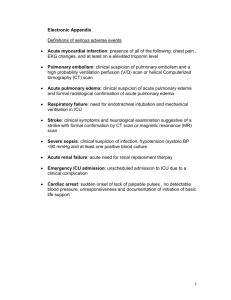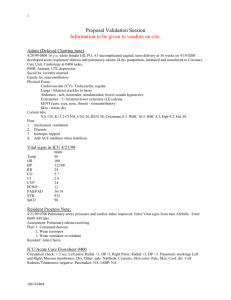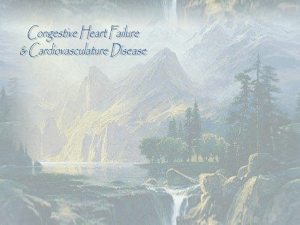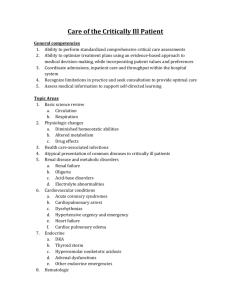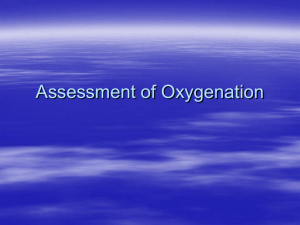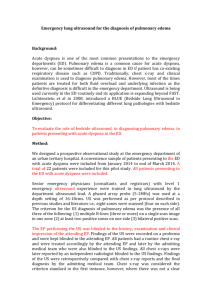Pulmonary Edema vs. Pneumonia: Paramedic Guide
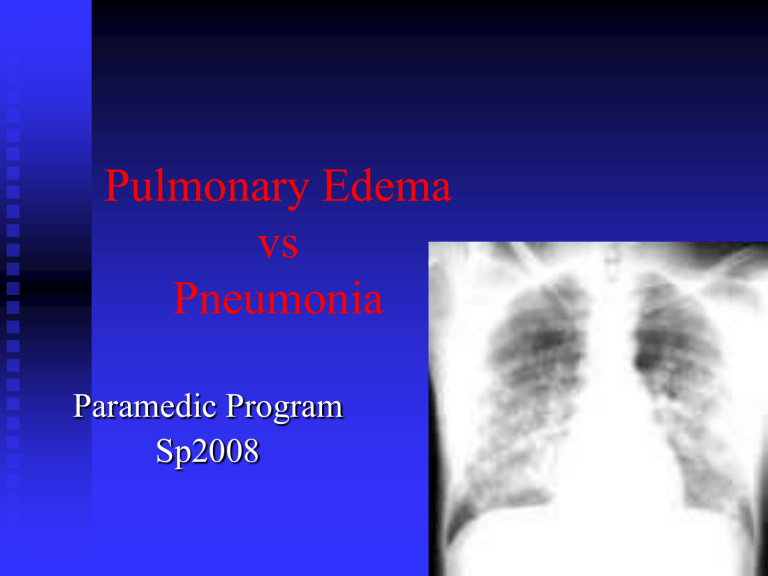
Pulmonary Edema vs
Pneumonia
Paramedic Program
Sp2008
Acute Pulmonary Edema, Hypotension, Shock
Clinical signs: shock, hypotension, congestive heart failure, acute pulmonary edema
Most likely problem?
Acute Pulmonary
Edema Volume problem Pump problem Rate problem
Bradycardia?
See algorithm
Tachycardia?
See algorithm
First-line Actions
Oxygen
Nitroglycerine SL
Furosemide 0.5 to
1mg/kg
Morphine IV 2 to10 mg
Administer
Fluid
Blood pressure
Let’s Review:
Cardiac Output
5000-6000 ml/min.
HR or SV = CO
Sympathetic effects:
HR and SV
Parasympathetic:
Slows HR
Little effect on SV
Review:
SV = pressure in ventricle
Frank Starling effect
Peripheral vascular constriction increases venous return
= Increased RV output.
Vasodilation of arteries decreases PVR and diastolic pressure
= Decreased CO.
Vital Signs
Normal B/P is 120/70 mmHg
Increases with age
General:
Systolic – 100 + age up to 140
At age 50: usually 140 mmHg
Increases 1 mmHg/yr after 50.
CHF Causes
Normal heart muscle
AMI
Left ventricular enlargement
Abnormal Cardiac Function
Dispatched as:
Man down
Chest pain
Heart attack
SOB
Fainted
Dizzy
Passed out
Choking
Stroke
DFO
DRT
Initial Assessment:
Brief History
O nset
P rovoking factors
Q uality
R adiation
S everity
T ime
BP changes
Initial Assessment
Meds
Cardiac rhythm
Abnormal breathing
Edema
Rales
Changes in skin color and moisture
Right and Left Heart Failure
Right Heart Failure
Causes
COPD
Left heart failure
Progression
Right ventricle cannot eject all of the blood
Fluid/pressure backs up
Right atrium
Venous system
Pedal edema, JVD
Left Heart Failure
Causes
High afterload
Progression
Left ventricle cannot eject all of the blood
Fluid/pressure backs up
Left atrium
Lung tissue
Alveoli
Pulmonary edema
Acute Left Ventricular Failure
Acute LVF from heart disease:
#1 cause of heart failure.
Assume the worst, hope for best
Pt. with CAD w/ hx of MI(new or old)
May develop LVF.
Frequently LVF is only manifestation of
AMI.
LVF
Common causes
Systemic HTN
Afterload
Coronary artery disease
Arteriosclerosis/atherosclerosis
Ischemia
Local/temporary occlusion
LVF
Common Causes
Infarction
Permanent, necrosis
Significant Sized Infarct
• Decrease effective wall motion
• Decreased stroke volume
Cardiomyopathy
• Alcoholism one of main causes
LVF
Other Causes
Volume overload
Bag of Potato Chips
Severe anemia
Hypoxemia
LVF and Pulmonary Edema
Incidence of CHF doubles per decade of life
> 3 million in US; > 400,000 new diagnoses/yr
5 yr mortality rate /p dx;
60% in men
43% in women
Basically this happens
Forward or backward ventricular flow.
Forward – (LVF) – reduced flow into aorta and systemic circulation
Backward – elevated systemic venous pressure
NY Heart Association’s classification of CHF
Class I
Not limited by symptoms
Class II
Fatigue, dyspnea, other sx with ordinary physical activity
Class III
Marked limitation with normal activity
Class IV
Symptoms at rest or with any activity
CHF
Acute CHF
Rapid
Chronic CHF
Slow
Midnight shoppers
Pulmonary edema also results from:
CVA
Pulmonary embolism
Infection - Sepsis
Allergy
Inhalation of fumes
Narcotic abuse
Especially Inhaled (Heroin)
Altitude sickness.
Acute Findings
History
Recent change in sleep patterns
More frequent trips to the bathroom
Need to sleep on more pillows at night
Recent move to the recliner at nights
New episodes of PND
•
Paroxysmal Nocturnal Dyspnea
• Sudden awakening with acute shortness of breath
•
Relieved after standing or sitting upright for a period of time (Midnight Walmart shoppers)
Acute Findings
History
Is more nitroglycerin needed to stop the episodes of chest pain?
Have nitroglycerin or oxygen doses increased incrementally in the last few days?
Acute Findings – Critical Patient
General impression/initial assessment
Labored respirations
Audible sounds
Tripod position
Frothy sputum
Retraction of chest muscles
Acute Findings – Critical Patient
General impression/initial assessment
Lung sounds
Wheezing, crackles
Middle-to-upper lung fields
Diaphoresis, change in skin color
Severe anxiety or restlessness
Tachycardia or bradycardia
Severe hypertension may be present
Pulmonary Edema – S/S
Tachypnea
Orthopnea
Paroxysmal Nocturnal Dyspnea
Elevation of pulmonary venous & cap pressures
Wakening from sleep
Pulmonary Edema – more S/S
Noisy Labored
Breathing
Fine crackles/Rales
Wheezes
Reflex airway spasm
“Cardiac asthma”
Coarse crackles/Rhonchi
(larger airways)
Coughing
Blood Tinged
Sputum
Pink Frothy
Normal chest xray
So, What to do?
Decide – Sick/NotSick?
Vitals
Look
Skin – wet/dry, color, temp
JVD
Peripheral edema
Subtle signs
Look
Listen
Breath sounds
Pulse x 6
Skin
Treatment of RVF
& LVF
CHF a circumstance not a Dx
Treatment objectives
Decrease myocardial:
Workload
Oxygen demand
Reduce fluid retention
Treatment
Decrease Workload
No Physical activity
Sitting upright
Oxygen
Pt may tolerate BVM
CPAP – studies are promising
Decreases preload and afterload in CHF
Improves lung compliance
BiPAP
CPAP but also delivers higher pressure during inspiration
Treatment
OMI
Oxygen, Monitor, IV
MONA if appropriate
Morphine, Oxygen, Nitro, ASA (Not in that order)
Don’t let patient walk!
Position of comfort
Reassure
Positive Pressure Ventilations if necessary
Treatment
Vasodilatory Therapy (Nitrates)
AMI reperfusion
Container expansion reduces preload
Morphine
Reduce Fluid Retention
Diuretics
Lasix
Bumex
Differential Diagnosis
Pneumonia
Herpes Zoster
Pleurisy
COPD
Rib fracture
Asthma
Angina
MI
Pneumothorax
Pancreatitis
Hepatitis
Salicylate OD
Bronchitis
Hyperventilation
Lung carcinoma
Sepsis
TB
Muscle pain
Costochondritis
Pericarditis
CHF
Percardial tamponade
Pneumonia
The statistics
Community acquired pneumonia
4.5 million cases annually in US
Winter months/Colder climates
More men than women
20% require hospitalization
6 th leading cause of death
Most common infectious cause of death
Viral
Upper and lower respiratory infections
Untreated, mortality > 30 %
37.7% in elder > 80 y/o
Sudden onset of S/S & rapid progression suggest bacterial pneumonia
S/S
Productive cough
Sputum may be
Green
Rust-colored
Current jelly
Foul smelling
Rigor or shaking chills
Headache
Malaise
N/V/D
Exertional dypsnea
Pleuritic chest pain, friction rub
Abdominal pain
S/S, cont.
Fever
Tachypnea
Tachycardia
Cyanosis
Wheezes, coarse & fine crackles
Anorexia & weight loss
Dullness to percussion
Altered mentation
typical pneumonia generally resides in the nasopharynx carried asymptomatically in approximately 50% of healthy individuals nosocomial pneumonia aspiration or inhalation; ~
45% of healthy people aspirate during sleep; even higher in severely ill patients; often bilateral
Pneumocystis carinii pneumonia
Bacterial pneumonia
Bacterial pneumonia
Viral pneumonia
Host Factors
DKA
Alcoholism
Sickle Cell
HIV
So – how do we tell the difference?????
CHF/Pulmonary Edema
Wheezes, fine & course crackles
Cardiac history
Productive cough
↑ dyspnea suddenly
JVD
Cyanosis
Finger clubbing
Prolonged expiratory phase
Tachypnea, tachycardia
Accessory muscle use
Paroxysmal nocturnal dyspnea
Pneumonia
Wheezes, Course & fine crackles
Febrile, chills
Productive cough
Hx URI, OM,
Conjunctivitis
Tachypnea, tachycardia
Cyanosis
H/A
Malaise
Abdominal distention
N/V/D
History
Recent Hx
Cough
Onset
BP
Pneumonia
N/A
Dyspnea Orthopnea potential
Fever, malaise, etc.
Productive, thick, green
Gradual
Normal
Pulm. Edema
HTN, Heart problems
Orthopnea
Acute Wt. gain
Edema in legs
Foamy sputum
Rapid
High
Meds Antibiotics, cold medicines
Digoxin, antiHTN, diuretics
Treatment Oxygen, Medneb, IV fluids
High flow O2
NTG, Lasix, MS
COPD/Asthma
Lung problems
Chronic dyspnea
Gradual Wt. loss
Productive
(bronchitis)
Gradual
Normal
Bronchodilators
Steroids
Oxygen, Med-neb
Rx
Treatment summary
Pulmonary Edema
OMI
MONA if approp.
Position of comfort
Nitroglycerin 0.4 mg
SL per protocol
Morphine 2-10 mg
Lasix per protocol
(commonly 40 mg)
CPAP if available
Pneumonia
OMI
Limit IV fluids if hx of cardiac disease
CPAP if available
Medications for Pulmonary edema
Nitroglycerine
Morphine
Lasix
Nitroglycerin
Drug Class: Nitrate vasodilator
Relieves myocardial workload
Dilates the arterial and venous systems
Reduces preload to the already overworked ventricles
Reduces blood pressure to reduce afterload
Allows pressure and fluid to move into the venous system
Sublingual doses start at 0.4mg
Morphine Sulfate
Drug Class: Narcotic Analgesic
Relieves myocardial workload as well
Dilates the venous and arterial systems
Reduces preload and afterload
May cause hypotension
Morphine Sulfate: Other Actions
Mechanism of action
Binds to opiate receptors throughout the
CNS
Slows respiratory rate at the medulla
Stimulates the nausea center in the brain
Morphine Sulfate
Administration
2-4mg over 1-2 minutes, every 5 minutes (usual max dose 10 mg)
Furosemide
Class: Loop Diuretic
Moves sodium out of the blood vessels early in the kidney
Water follows sodium into the kidney tubules
The site pulls out potassium as well
Provides some vasodilation within 5 min.
Diuresis within 20-30 min.
Furosemide
Reduces preload
vasodilation
Pulls the extra fluid out of the circulation
Keeps fluid moving out of the kidney
Medication effects
Effects seen within 5-15 minutes of administration
Peaks in 30 minutes after administration
Furosemide Administration
20-40mg IVP over 1-2 minutes
Double the dose if the patient is currently taking a diuretic
Relief of symptoms should begin within 5 minutes
If no relief, consider BVM
SHOPS drugs – CHF patients
Street drugs
Herbal drugs
OTC drugs
Prescription drugs
Sexual enhancement
Street drugs may contribute to
CHF
Cocaine
Meth
Inhaled solvents
PCP
Possibly helps
High-rite
Aqua-rite
L-arginine
Magnesium
Berberine
Herbal remedies
Possibly hurts
St. Johns Wort
Ephedra
Ginko Biloba
Kava Kava
Licorice
Ginseng
Aconite
Alisma plantago
Bearberry Buchu
Couch grass
Dandelion
Horsetail rush
Juniper
Over-the-counter drugs (OTC)
Cold Medications
Common Prescription medication for CHF/Pulmonary Edema
(Calcium channel blocker)
Amiodarone
Norvasc
Ace Inhibitors
Vasotec
Capoten
Lotensin
Accupril
Altace
Angiotension II receptor blockers
Cozaar
Avapro
Beta Blockers
Coreg
Sexual enhancement drugs
Viagra
24 hours
Cialis
36 hours
Levitra
unknown
